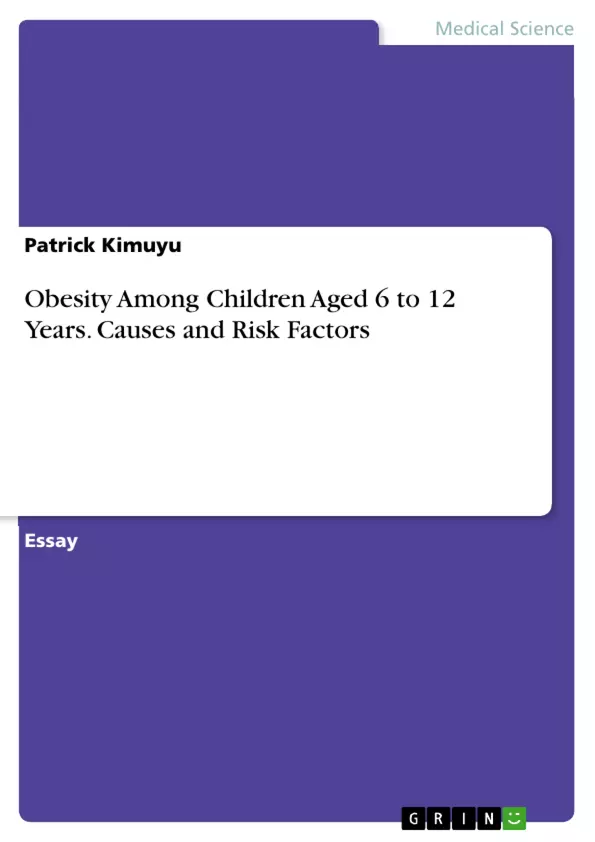Obesity among children aged 6 -12 years has become an enormous challenge to the global healthcare systems. Currently, the prevalence rate of obesity has reached the highest range in the past two decades and this is attributable to the low well-being and overall health among children which is estimated to have decreased by 37% compared to the case in 1970s.
Childhood obesity is distributed to all parts of the world even though western countries have long been associated with high prevalence, but such trends seem to have changed. Currently, developing countries account for about 35 million obese and overweight children of the total 43 million, globally.
Obesity among children poses risk to the future adult generation; thus, it requires appropriate intervention to reduce its burden. It is believed that socio-economic factors are to blame for the high prevalence of childhood obesity. For instance, economic and educational statuses of households influence the lifestyle of family members, especially with regard to dietary habits. Therefore, introducing health measures to promote health education among children and the young people in educational systems will help to reduce its prevalence in future; thus, reducing its burden.
Inhaltsverzeichnis (Table of Contents)
- Introduction
- Epidemiology of Childhood Obesity
- Causes and Risk Factors
- Reason for Increased Rates of Childhood Obesity
- Socio-economic Status Link to Childhood Obesity
- Educational Status
- Economic Status
- Physical Activity and Sedentary Lifestyle
- Neighborhood Environments and Childhood Obesity
- Solution to Childhood Obesity
- Conclusion
Zielsetzung und Themenschwerpunkte (Objectives and Key Themes)
This research paper aims to provide a comprehensive overview of childhood obesity, focusing specifically on the role of socio-economic status as the primary driver of its increasing prevalence rates over the past two decades.
- The epidemiology of childhood obesity, particularly its global spread and increasing prevalence.
- The key causes and risk factors of childhood obesity, including dietary habits, physical activity, and genetic factors.
- The impact of socio-economic status on childhood obesity rates, highlighting the disparities in prevalence between different socio-economic groups.
- The relationship between physical activity, sedentary lifestyle, and childhood obesity.
- The influence of neighborhood environments, including access to recreational amenities and health-promoting facilities, on childhood obesity rates.
Zusammenfassung der Kapitel (Chapter Summaries)
The introduction sets the stage for the research paper by defining childhood obesity and outlining its significance as a growing global health concern. The prevalence rates of childhood obesity have been increasing for the past two decades, leading to a shortened life expectancy for current children compared to their parents due to the burden of obesity-related diseases.
The epidemiology section explores the global spread of childhood obesity, highlighting its presence not only in Western countries but also in developing nations. It also provides statistics on the increasing prevalence rates of childhood obesity worldwide.
The section on causes and risk factors explores the primary contributors to childhood obesity, which include a reduction in physical exercise, poor dietary habits, genetic factors, and socio-economic situations.
The chapter dedicated to the reason for increased rates of childhood obesity delves into the connection between socio-economic status and obesity prevalence. It presents research findings that highlight the significant correlation between lower socio-economic status and higher rates of childhood obesity.
The chapter on the socio-economic status link to childhood obesity examines the specific ways in which different aspects of socio-economic status influence childhood obesity. It explores the disparities in obesity rates between children from high and low socio-economic backgrounds, highlighting the influence of factors like education and income status.
The chapter on physical activity and sedentary lifestyle examines the impact of physical inactivity and sedentary behaviors on childhood obesity. It discusses the link between access to recreational amenities and obesity rates, showing that children with limited access to these facilities are more likely to be obese.
The final chapter under consideration, focusing on neighborhood environments and childhood obesity, explores the influence of neighborhood factors on obesity rates. It highlights the role of access to health-promoting amenities, including sidewalks, walking paths, community centers, and playgrounds, in shaping children's physical activity levels and, consequently, their risk of obesity.
Schlüsselwörter (Keywords)
The primary focus of this research paper is childhood obesity, its epidemiology, causes, and contributing factors, particularly the role of socio-economic status. Key terms include childhood obesity, pediatric obesity, socio-economic status, physical activity, sedentary lifestyle, neighborhood environments, prevalence rates, and health disparities.
- Quote paper
- Patrick Kimuyu (Author), 2016, Obesity Among Children Aged 6 to 12 Years. Causes and Risk Factors, Munich, GRIN Verlag, https://www.grin.com/document/381225



